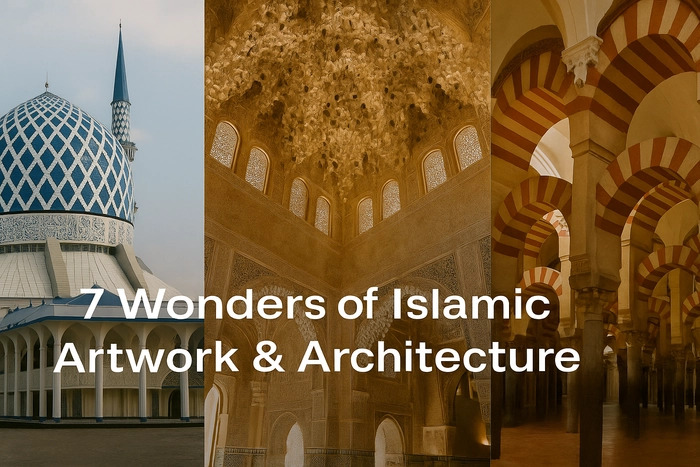The Hidden Language of Stone and Light
Quick challenge: Close your eyes and imagine art that speaks without words. That's Islamic artwork for you—a visual language so powerful it has survived centuries, crossed continents, and continues to inspire architects and artists worldwide.
Decoding Islamic Architecture: More Than Meets the Eye
Did you know? The intricate Islamic designs you see aren't just decorations. They're mathematical marvels, spiritual statements, and cultural time capsules rolled into one. Each pattern tells a story of innovation that would make modern contemporary architects green with envy.
The Magnificent Seven: Secrets No Tour Guide Will Tell You
The Alhambra
What if I told you the Alhambra is basically a 14th-century computer?
Its Moorish architecture isn't just beautiful—it's a sophisticated mathematical system. Those mesmerizing geometric patterns? They're actually complex algebraic equations transformed into visual poetry. The designers used principles of symmetry and repetition that would make modern mathematicians weep.
Unique Insight: The water systems in the Alhambra were so advanced that they created microclimates, cooling entire rooms before air conditioning existed. Imagine an architectural wonder that's both an artwork and a climate control system!
Dome of the Rock
Here's a mind-blowing fact: The Dome of the Rock is more than a mosque design. It's a perfect example of how Islamic architecture elements blend scientific precision with spiritual symbolism.
Its octagonal design isn't random. It represents the intersection of earthly and divine realms. Each tile and arch tells a story of cosmic balance that goes beyond mere construction.
Great Mosque of Cordoba
Before globalization was a buzzword, the Great Mosque of Cordoba was the ultimate cultural mixer. Arab architecture met European design, creating something entirely revolutionary.
Those famous red and white arches? They weren't just beautiful. They were an architectural rebellion, challenging every design convention of their time. It was the 8th-century equivalent of a mic drop in architectural history.
Blue Mosque
Imagine a building that speaks through color. Istanbul's Blue Mosque doesn't just display Islamic designs—it communicates through 20,000 handcrafted tiles that each tell a story.
Pro Tip: Those blue tiles aren't just decorative. In Islamic culture, blue represents infinity, spirituality, and divine protection. Every shade is a carefully chosen word in a visual conversation.
Shah Mosque: The Pixel Art of the 17th Century
Before digital design, Persian architects were creating pixel-perfect Islamic geometric art. Isfahan's Shah Mosque is essentially a massive, intricate mosaic where every tile is a carefully placed "pixel" creating a larger narrative.
Taj Mahal: Engineering Meets Emotion
Beyond being a love monument, the Taj Mahal is an engineering marvel. Its perfect symmetry isn't just aesthetic—it's a mathematical statement. Those marble inlays? They're so precise that gaps are nearly invisible, a testament to the craftsmanship that would challenge modern precision tools.
Topkapi Palace: The Original Big Data Center
Before digital archives, Topkapi was humanity's most sophisticated information center. Its manuscript collection was the 16th-century equivalent of today's cloud storage—a place where knowledge was curated, protected, and celebrated.
Why These Stories Matter: The Global Impact of Islamic Architecture
These aren't just monuments—they're living proof of how world famous architecture transcends geographical and cultural boundaries. Each landmark represents a profound narrative of human innovation:
-
Architectural Style Beyond Borders The Great Mosque of Cordoba isn't just a Spanish landmark; it's a testament to how Islamic architecture design can blend multicultural influences, challenging narrow definitions of cultural boundaries.
-
Cultural Preservation Through Art Modern Islamic architecture learns from these historical masterpieces. The intricate Islamic geometric shapes aren't mere decorations—they're sophisticated mathematical languages that preserve cultural memory.
-
Technological and Spiritual Innovation From the dome structure of religious buildings to the precise water management systems of the Alhambra, these structures prove that the best architecture emerges when technology meets spiritual imagination.
-
A Global Design Philosophy Contemporary architects continue drawing inspiration from these Islamic architectural wonders, demonstrating that true innovation respects historical wisdom while pushing creative boundaries.

